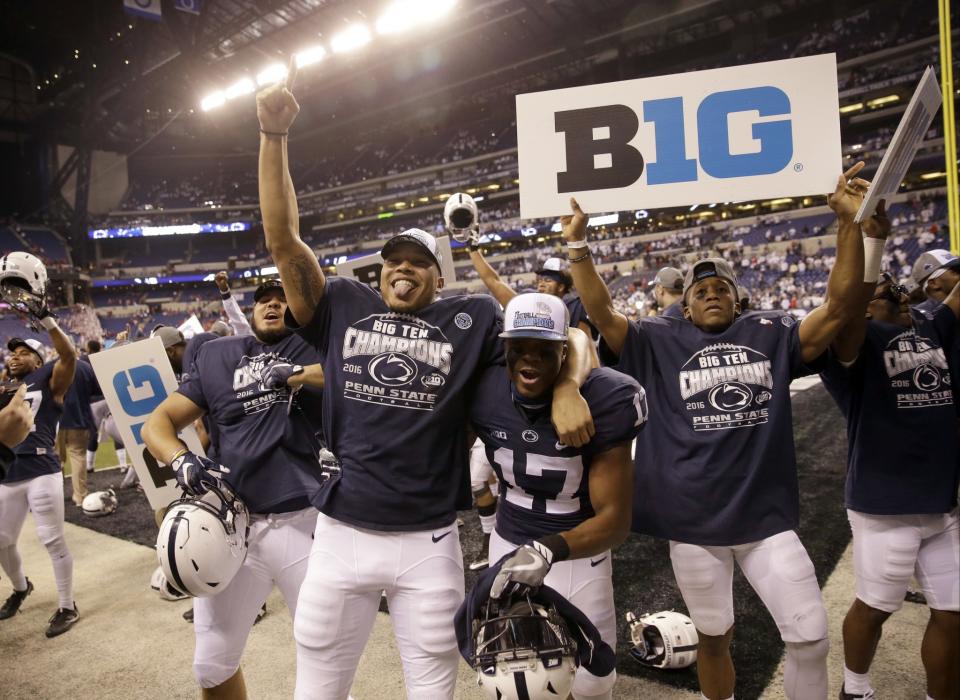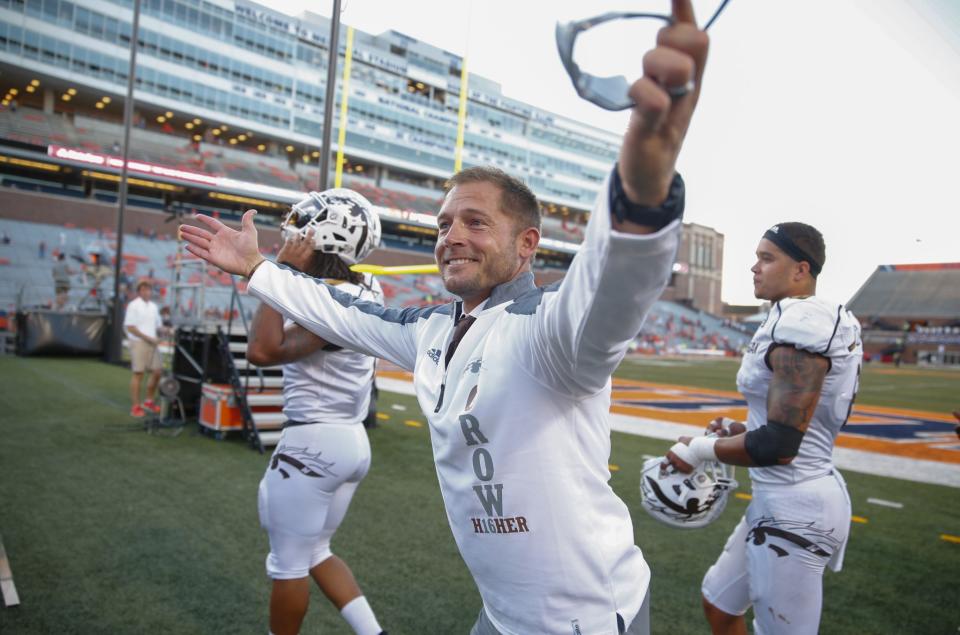What college football needs to do to make an eight-team playoff a reality
You want an eight-team playoff, the bigger, bolder (and inevitable) successor to the current four-team stopgap compromise currently in place?
Sure, easy. Here’s one below that would be vastly superior for the sport.
Stick around after, however, to consider the challenges at hand, the heavy lifting required to get it right and why college football might not want to jump right now.
First, however, here’s the fun, wave-a-magic-wand stuff:
Start with an eight-team field, with each of the five major conferences earning an automatic bid for their champion, however each conference wants to determine such a thing. Then eliminate conference championship games.
Ohio State getting in over Penn State in a year Penn State won the Big Ten championship, won the Big Ten East and defeated the Buckeyes head-to-head is proof the committee and the sport has evolved intellectually to the point where a title game is just another “data” point anyway.

So just end it. The Big 12 and its pure round-robin system was the best before. Don’t make the league go dysfunctional just because every other bloated league is.
If there’s a dispute between two teams that didn’t meet, figure it out. With as many as three at-large spots available, there’s a good chance both teams will make it somehow. Since not all conferences are created equal, the at-large spots assure high quality non-league champs such as Ohio State have an avenue to the playoff. It also provides access to independent programs.
• Create a provision for a sixth automatic bid to the Group of Five smaller leagues if their champion achieves a certain standard to be determined by the selection committee. Maybe top 10 or 15. If a team qualifies, then there are only two at-large bids. If not, then there are three.
Does this mean this year’s candidate, 13-0 Western Michigan, which came in ranked 15th, is one of the top-eight teams or a legitimate threat to win three games and the national title? No. Not really. A playoff is a product, though, and a product needs to be sold. Introducing a reasonably deserving Cinderella is not a bad thing, especially when the eighth-best team from major conferences routinely would have three losses. It works great in other sports. Even a single upset would be epic.
Also, by putting a weaker team at No. 8, you, in turn, reward No. 1, in this case Alabama. If the game turns out non-competitive, then so be it. Alabama deserved the easier first-round game.
One of the issues of an expanded playoff is it minimizes the accomplishments of the top teams. So there has to be incentives. Right now, Alabama, despite earning the top seed with a dominating perfect season, has little to no tangible advantage over No. 4 Washington. The game will be played in Atlanta, which is closer to Alabama, but that isn’t much. Getting Western Michigan? That’s an advantage.
• The other advantage, of course, is to move the quarterfinals and semifinals to on-campus sites. The championship game can be played on a neutral field, just like the NFL. The benefits are numerous. Getting Western Michigan in Tuscaloosa would be a real advantage.
• With home sites in use, becoming a top-two seed, or a top-four seed, is a major accomplishment. That would make more games matter across the season – Alabama, for instance, had little to gain in Saturday’s SEC championship game. Even if the Tide lost, they would have still made the four-team playoff. With home field at stake, though, a win would’ve been paramount.
• On-campus environments are a large part of college football’s charm. The Horseshoe, the Big House, Death Valley, the Swamp – with the rare exceptions of Green Bay or maybe Buffalo, there isn’t an antiseptic NFL stadium that can compare. Travel burdens for fans are relaxed (at least half of them). Wild crowds are reintroduced. Weather can become a factor.
It is win-win-win.
• This generates additional revenue, because, for the most part, college stadiums are larger than bowl sites. More notably, third-party middlemen (bowl directors) are cut out of profiteering off “amateur” sports as college football finally frees itself of the fiscally irresponsible act of outsourcing its most valuable asset, the football playoff. Bowls can continue (and will) to serve non-playoff teams, but the bowl industry no longer gets to control things.
• Not only does this cut down on the financial burden for fans trying to travel to multiple neutral sites, but economic impact is now generated for college towns that support the sport year-round. It’s not college football’s job to pump tourist dollars into random communities. This isn’t the 1920s anymore.
• With no conference title games, just end the college football season on Thanksgiving weekend. You can stage Army-Navy on the first weekend of December, or they’ll just have to move in line with the rest of the country. After a week off, hold round one of the playoffs the second weekend of December. Semifinals are three weeks later on Jan. 1 (or Jan. 2 if it’s a Sunday) and the title game is a week to 10 days later.

There is downtime for physical and mental recovery. By killing the conference title games, almost no teams will play extra games. The first round of the playoff would generate more money than the conference title games. And this year you’d get something like this:
No. 8 Western Michigan at No. 1 Alabama
No. 7 Oklahoma at No. 2 Clemson
No. 6 Michigan at No. 3 Ohio State
No. 5 Penn State at No. 4 Washington
Winners meet at the home field of the higher remaining seed.
Think that might be something that would interest you? Say one game on Friday night, then a triple-header on Saturday?
Now, this isn’t easy, even if perhaps it should be. The reality is college football is a sport and a business, in transition.
The playoff represents that reality, a hodgepodge of special interests, old traditions, modern developments and conflicting goals.
It’s worth noting that the four-team playoff is entering only its third year, so while there are obvious flaws and it has changed the game in certain ways, there’s still a lot to observe and analyze. And with 128 teams ostensibly playing for one title, no system is perfect.
As such, moving to eight teams without dealing with the underlying issues of college football is ill advised. Here are some questions:
• What’s a “conference” these days? And why hold conference championship games when they intellectually should carry no additional weight but are simply another game?
Penn State won its division and conference and it didn’t help much. If that’s the way it’s going to be, then why bother? What is a conference anyway? Once, there was familiarity and commonality and convenience. There was round-robin scheduling. Now? These are conglomerates built to increase TV revenue and nothing else.
During the 12 years running from 2014-25, Georgia will play fellow SEC member Texas A&M twice and not visit College Station until 2024. The Bulldogs will play non-league opponent Georgia Tech 12 times and visit Atlanta six.
So which is the “conference” game? And why should losing a conference game be more damaging to a playoff résumé (because it may keep them from the conference title game) than a loss to a more familiar local rival?
Conferences may have once meant something. Then greed and expansion and divisions weakened them. Pretending otherwise is ridiculous, but is staid college football fully ready to embrace reality?
• Why allow the bowl industry to successfully hold the field to four because they fear home playoff games will impede their business when they should hold no such strangle hold on the sport? Cronyism remains the greatest – and most obvious – obstacle to the future.
• Are teams allowed to improve over the course of the season or is the ethos of the sport still rooted in the poll era where complete dominance from super teams, perceived or real, was everything?
Back in the day, there were no scholarship limits, so big programs could carry 200-man rosters and starve other local programs of talent. Not every school invested in its program the way many do now. Media coverage, particularly on television, was limited and thus favored a few brand names. Recruiting was more local. This led to the creation of some great teams.
Today the sport is mostly full of parity – just one of the past five national champions went unbeaten (2014 Florida State).
College football is one of the only sports that expects wire-to-wire domination and doesn’t do much to recognize an uptick in play. Penn State lost twice in September but got things in order and reeled off nine victories. Oklahoma did the same and won eight. Southern California was a far different team in November than early in the season.
What’s that worth? What should it be worth? Were those teams better off playing weaker non-conference schedules, like Washington did? Did they doom themselves by risking early season exposure? The sport is better if tough non-conference play is rewarded.
• How long will there be five major conferences?
I used to argue the old Big East should have lobbied and begged for an eight-team playoff with six automatic bids to the six-best conferences. It was its only chance for survival because it could offer a tangible thing – playoff access – to teams that might otherwise bolt to be a second-tier team in a bigger conference.
It chose the status quo and now no longer exists for football. I’ve been arguing almost as long for the Big 12 to follow the same path. The Big 12 will never be able to offer Texas or Oklahoma more money than the SEC or Big Ten, but an easier path to the playoff is possible. Yet the conference isn’t pushing for the playoff expansion/auto bid, either. Good luck with that.
That said, while the trend may look at Texas and Oklahoma leading a breakup of the Big 12 in the next decade, leaving the sport with just four major conferences, there’s also a scenario where mega-conferences fray and break and wind up … smaller.
The SEC, Big Ten, Pac-12 and ACC were built to maximize subscribers for their conference television networks. The Pac-12 hasn’t been as successful and the ACC’s doesn’t exist and likely never will. The SEC and Big Ten Networks have been cash cows, but for how long?
As cord cutting and streaming services gut the conference-run TV network subscription numbers, previous expansion reaches go from increasing revenue to becoming unproductive mouths to feed against dwindling resources.
Hundreds of thousands of customers are dropping ESPN each month. If ESPN’s subscription numbers are shaky, then someone like the Big Ten Network has to be dire. While there is plenty of quality broadcasting on the channel they rarely deliver significant ratings, even for live games. And while diehards might continue to subscribe, few others will.

The Big Ten and SEC Networks were de facto “college sports taxes” on the people of their home states. There was no way that a $15-a-year tax would ever pass. By getting the network on basic cable at a cost of $1.10 a month, however, they were able to collect that much from every house that had cable. That used to be almost everyone.
Now, that number is getting lower each month as people turn away from costly basic cable. It has every sports league in the country concerned – and if the NFL is paying attention then college sports conferences should be terrified. So where are we in 2020 or 2025? The whole reason for recent expansion is now built on quicksand.
Whatever fiscal sense Rutgers joining the Big Ten made in 2016 – adding New Jersey cable homes – might not in 2025 … or sooner.
If so, does the Big Ten stay at 14 and keep trying to prop everyone up when revenue gets tighter? Or does a core group break off? Or does an even tighter group of big schools link up with the big schools from other conference and create a couple mega conferences to try to salvage television revenue?
No one knows, other than the tsunami appears to be coming. While nothing seems imminent or even likely, nothing is impossible either. It’s certainly no less impossible than predicting Rutgers would be in the Big Ten in the first place.
Then, there is the rarely addressed – yet highly pertinent – concerns of player safety (more games) and compensation (more money). College football clock rules, which could reduce the number of plays per game need to be altered. Reductions on full-contact practices, especially in the spring, should be adopted. NFL players don’t deal with the amount of practice contact that college players do. That’s because they have a union to negotiate safety.
• Already, the playoff acknowledges a debt to the athletes in the big-money playoff. They offer free travel to games for families. It may be a pittance compared to what is earned, but is a glimpse into the truth that more is needed.
The best solution remains freeing players to profit off their names and likenesses similar to the Olympics – which made the move away from the bogus concept of “amateurism” in the 1980s and saw everything grow more popular. People aren’t upset that Michael Phelps and Usain Bolt can hawk sneakers and sandwiches. It just makes them more famous and keeps them in the Olympics longer.
There is no harm in Deshaun Watson getting paid $500 (or heck, $5,000) to spend a few hours on a Sunday at an Anderson, S.C., car dealership, signing autographs and thus bringing in potential customers to check out the new Chevys.
Let the free market work. This way the schools aren’t “paying” anyone and can avoid all sorts of complications. There are no Title IX issues – here’s guessing Connecticut women’s players can make some money, too.
Yes, some star players would make money and lower ones wouldn’t, but NCAA sports are full of some players on full rides, some on partial rides, some as walk-ons. The athletic director and department secretary aren’t being paid the same, and no administrator seems too broken up about it.
If a big-revenue-producing expansion is under way, then athlete rights have to move in lock step, philosophical issues need to be hashed out, major structural changes have to take place.
College football deserves an eight-team playoff, but what it really needs is a well-planned and well-designed eight-team playoff that works for the future … whatever that might entail.

